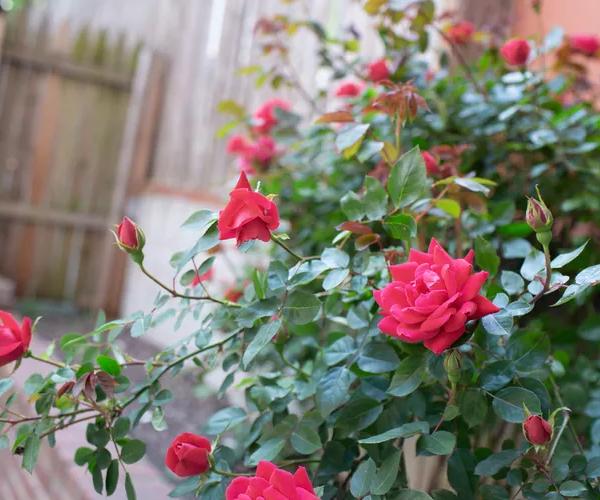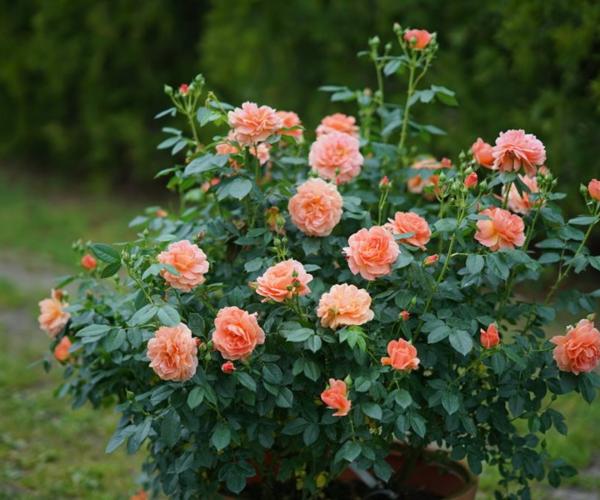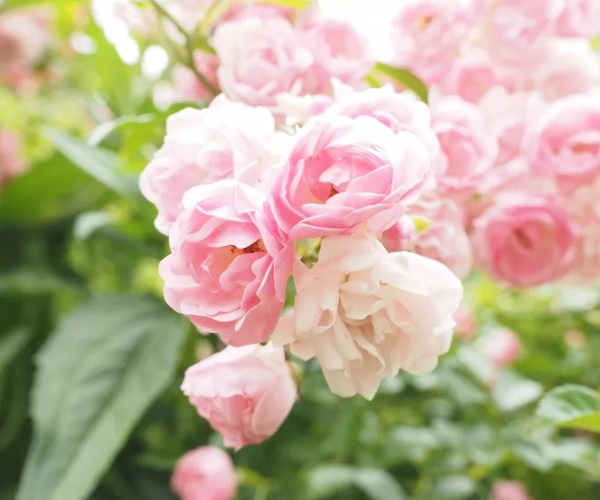If you have roses in your garden and you’re wondering what to plant along with them, then you have to choose the ones that can look beautiful, improve the growing conditions of the plant, and also solve gardening problems. There are many varieties that you can choose to ward off pests and improve soil quality and plant health in numerous ways.
Choosing companion plants that are good for roses is necessary because they thrive in the same sun exposure and soil type and USDA zones have mainly same growing requirements. Some plants like catmint, lavender, and verbena are some basic examples of companion plants for roses.
What are Roses?
A rose (Rosa rubiginosa), are members of the Rosaceae family and they are probably the most popular flowering shrubs for landscaping. The Rosa genus has more than 300 species of woody flowering perennials and numerous thousands of types of roses are cultivated within that species.
While every continent has native roses, most landscape types are multi-generational hybrid cultivars for which the original species’ ancestors no longer exist. When you buy a modern rose variety from a nursery, it is almost always sold in a unique cultivar name rather than by a species name.
You have to understand a rose’s classification, its growth habits, and other traits. Most roses do best when planted in full sun and well-drained soil.
Also, Read What is Variegated Plants? Here’s What You Need to Know!
Categories of Roses
Only when you know the class in which the rose falls, you will fully understand its characteristics. There are different ways to classify roses. For example, one can know the type of roses by breaking down their colors and blooms.

Many garden experts split the various types of roses into three categories: old garden roses, modern roses, and wild roses. The old garden roses category includes a type of rose that was in existence before 1867. They only had one bloom period per season but emitted a luscious fragrance during that time. Modern roses are the varieties that came into existence after 1867 and are popular for their large flowers and continuous blooming pattern. Wild roses are the ones that grow in the wild, without any hybridization or the cross-breeding that other types have.
Some popular class of roses
- Hybrid tea rose: One of the most well-known types of roses is the hybrid tea roses which consist of large ornate blooms with 30 to 50 petals and long stems. There are hundreds of hybrid tea rose breeds, with new introductions constantly replacing outdated varieties.
- Grandiflora rose: This one class is the subgroup of hybrid tea roses, so it is also one of the most popular types of roses. It is often very tall, with blooms appearing in clusters rather than individually on the stems.
- Floribunda rose: Other than hybrid teas and grandifloras, this is the next most popular rose type. They are also the best to grow since they are super easy to care for compared to the aforementioned two types. Like a grandiflora, it blooms in clusters. But this type blooms continuously, whereas hybrid teas and grandifloras bloom in six- to seven-week cycles.
- Polyantha rose: This category resembles floribunda, but the plants are shorter and the blooms are smaller. These are often used for edgings and hedges.
- Miniature rose and miniflora rose: A “miniature” rose is a shorter, more compact form of hybrid tea or grandiflora. It grows between 15 to 30 inches tall. A “miniflora” rose has intermediate-sized flowers, smaller than a floribunda but comparatively larger than a miniature.
- Shrub rose: These roses have a sprawling growth habit, growing from five to 15 feet in all directions. Famous for cold hardiness and vigorous flower cluster production, this group has many subcategories. An important one is the David Austin English Rose category, which has varieties resembling old garden roses with recurrent blooming and pleasant fragrances.
- Climber/rambler rose: This category includes any rose that features long, arching canes that can be trained onto fences, trellises, arbors, and pergolas. Now you can understand why a grandiflora rose is described as a climber. Climbers or ramblers are not clinging, or twining plants; they need to be tied to vertical supports to grow upward. Many climbers and ramblers are quite cold-hardy when compared to hybrid roses.
Plant That Looks Good with Roses
While choosing companion plants, it is also necessary to understand the texture, color, and form of them. Snapdragons which have tall spires complement the wide, cup-shaped flowers of roses. Perennials and shrubs with pale green, silver, or purple leaves like English lavender, on the other hand, accentuate the luxurious rose blossoms.

Another pro of having companion plants is that they can extend the flowering season by providing color between the main flushes of rose bloom in early summer and fall. Annuals like lantana and verbena which prefer the sun fill in the space around roses and also have the same light requirements.
Plants That Solve Problems for Roses
Some plants solve problems for roses. The feathery purple and blue-gray catmint (Nepeta) gracefully balances a pale pink rose and its feathery spires beautifully hide any blemishes that may occur on the rose’s foliage.
Despite the top of the rose being lush and attractive, the bottoms can sometimes be sparse and leggy. There are also good companion plants to hide those bare legs. Lavenders (Lavandula), catmint (Nepeta), and tall growing pinks (Dianthus) all make good partners. These companions also act as mulches as they suppress weeds and gently shade the soil, keeping the rose roots cool and moist.

Plants That Don’t Compete with Roses
While proper rose companions need the same growing conditions, they don’t compete aggressively with the roses. Roses thrive fully in the best sun and well-drained soil, and so should their companions. If you plant plants that are too aggressive, they may absorb too much water and nutrients from the soil and that may not be so good for the roses.
Many sun-loving annuals like heliotropes (Heliotropium), lantana (Lantana), verbena (Verbena), and million bells petunia (Calibrachoa), sustain throughout the summer and properly fill the space among roses. They have decent water needs that will benefit from the heavy watering regime that roses demand.
Plants That Discourage Pests
Good companions also should be the ones that enhance each other’s growth and protect each other from external harm. Some companion plants help discourage pests without the use of chemical insecticides because they have natural substances in their leaves, flowers, or even roots that keep insects at bay.
Onion family members like chives, ornamental alliums, and edible onions help increase the fragrance of the rose, deter aphids, and prevent black spots. Other aromatic plants and herbs also make wonderful companion plants and may help to drive away Japanese beetles and aphids.
Pests deterring plants
- Scented geraniums (Pelargonium): This favorite flower repels Japanese beetles and cabbage worms.
- Rue (Ruta): The strong scent of therue plant repels ants and beetles alike.
- Feverfew (Tanacetum parthenium): This plant repels bees and flies because it contains pyrethrin.
- Parsley (Petroselinum): Parsley is known to repel beetles and attract beneficial insects instead.
- Thyme (Thymus): This herb keeps whiteflies and hornworms away.
- Marigolds (Tagetes): One of the strongest scented flowers, they guard against aphids and whiteflies.
- Culinary sage (Salvia): The strong scent of sage repels snails and cabbage moths.
- Anise-hyssop (Agastache): This plant can repel pests such as cabbage moths.
- Russian-sage (Perovskia): This plant has aromatic foliage that spider mites and aphids shy away from.
- Lavender (Lavandula): The sweet and pleasant smell of lavender scares away many types of moths and flies.
- Yarrow (Achillea): Yarrow repels many a flying pest and its natural oils are said to be stronger than some chemical repellants.
- Oregano (Origanum): This herb’s peppery aroma repels cabbage worms and beetles.
- Catmint (Nepeta): The minty-flavored leaves are known to repel squash bugs as well as aphids.
Tomatoes reportedly prevent black spots, though many people don’t understand the combination of roses and tomatoes growing together. Lavender and catmint keep rabbits away. Four o’clocks (Mirabilis) and larkspur (Consolida) lure rose-loving Japanese beetles to eat their poisonous leaves. Yarrow attracts ladybugs who in turn feed on aphids.

How to Plant Rose Companions
It is necessary to plant rose companions almost a foot away from your roses so that they don’t disturb their roots. Leather gauntlet gloves are a necessity when working in your rose garden. Thorn-resistant kidskin leather molds to your hands and stress points at your thumb and fingertips are reinforced for long-lasting wear.
Develop good pruning practices for creating a healthy open structure for your roses. Be mindful of always maintaining good air circulation around your roses so that the plants are free from pests and diseases. If given proper care, you’ll be able to surround your roses with interesting companion plants.
FAQs
Q: What kinds of plants should not be planted with roses?
A: Plants with long root systems, such as shrubs, should not be planted next to roses, because they will compete for resources and space in the soil. Additionally, any plants that prefer wet soil will not grow well next to roses, which prefer well-draining soil.
Q: Can you plant vegetables with roses?
A: Yes, roses are great companion plants for vegetables, because their signature flowers attract pollinators. Roses can sometimes even act as a light trellis for climbing vegetables, such as beans. Be wary of pesticide use on your roses if they are planted next to the vegetables you intend to eat.
Q: What is a good groundcover to plant around roses?
A: Popular groundcover options to plant around roses include catmint, creeping phlox, and alyssum, just to name a few.
Also, Read Should You Add Banana Water and Eggshells to Your Plants? Experts Reveal!
